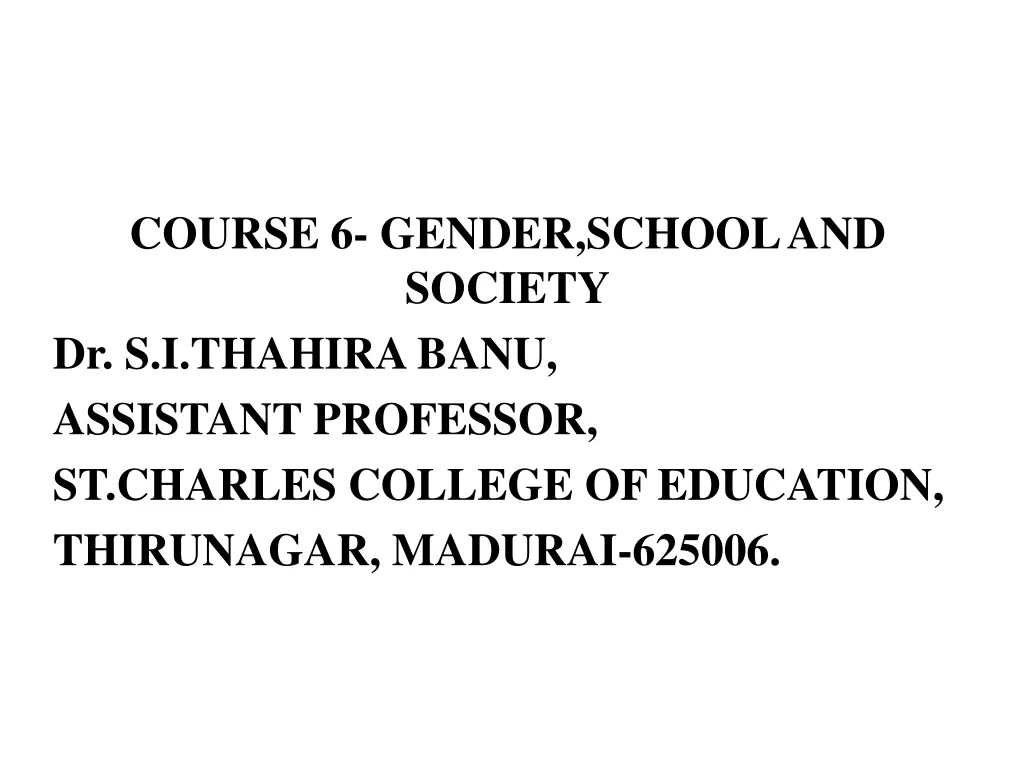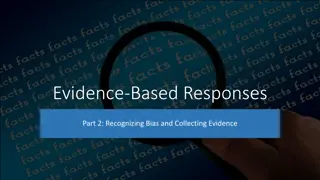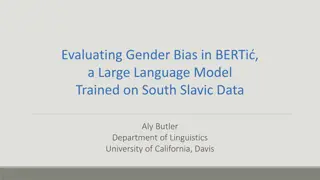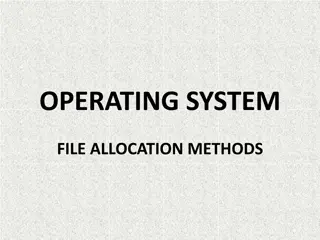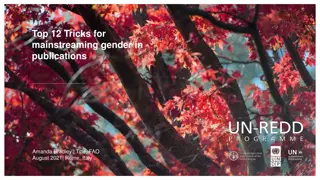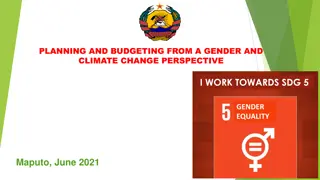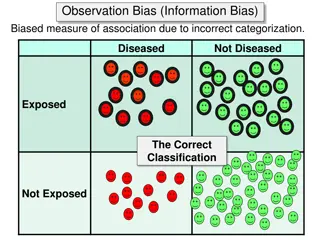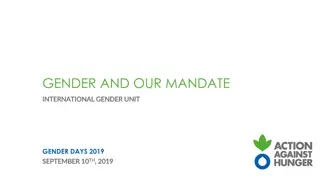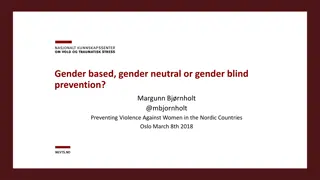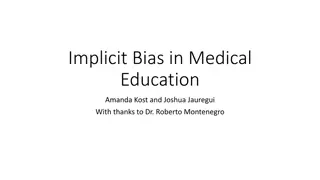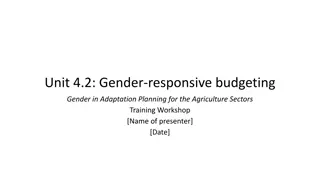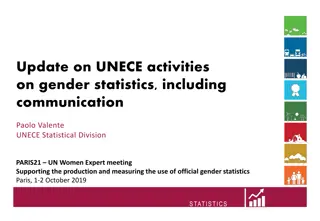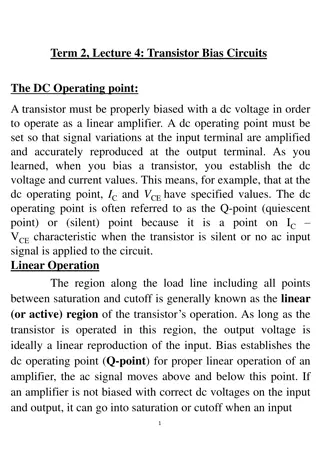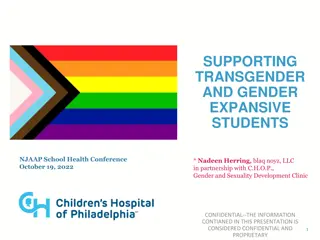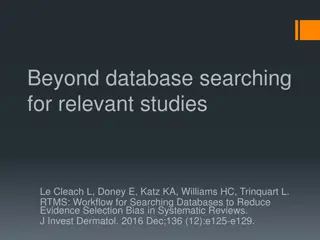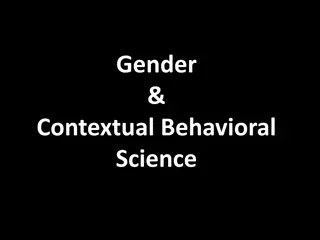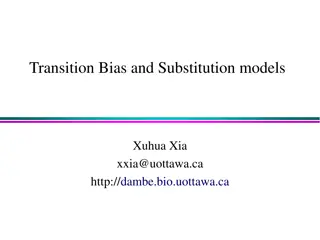Gender Bias in Grant Allocation: Methods and Findings
This presentation explores gender differences in grant allocation methods and presents findings from research conducted by Peter van den Besselaar and Charlie Mom at TMC Research Amsterdam and Vrije Universiteit Amsterdam. The study delves into research questions, relevant variables, indicators, studying gender bias, results from quantitative case studies, and conclusions, aimed at shedding light on gender bias in the grant application process. The presentation also discusses criteria mentioned by reviewers/panelists, merit, and other criteria in the context of grant allocation.
Download Presentation

Please find below an Image/Link to download the presentation.
The content on the website is provided AS IS for your information and personal use only. It may not be sold, licensed, or shared on other websites without obtaining consent from the author.If you encounter any issues during the download, it is possible that the publisher has removed the file from their server.
You are allowed to download the files provided on this website for personal or commercial use, subject to the condition that they are used lawfully. All files are the property of their respective owners.
The content on the website is provided AS IS for your information and personal use only. It may not be sold, licensed, or shared on other websites without obtaining consent from the author.
E N D
Presentation Transcript
Gender differences in grant allocation: methods and findings Peter van den Besselaar & Charlie Mom TMC Research Amsterdam - Vrije Universiteit Amsterdam Presentation for the 2nd GRANteD Conference - October 19, 2023
Acknowledgments This presentation uses the following material from the GRANteD project D2.1: Theoretical framework Van den Besselaar, Mom, M ller; Cruz-Castro, Sanz-Menendez D3.3: Grants and careers Sandstrom; Mom, Van den Besselaar, M ller D4.1: Indicators Van den Besselaar, Mom, M ller; Sandstr m; Cruz-Castro, Sanz-Menendez D4.2: Case studies in grant evaluation Van den Besselaar, Mom, M ller; Cruz-Castro, Sanz-Menendez; Sandstr m D4.3: Overview of the cases M ller, Van den Besselaar, Mom D6.2: Using linguistics to analyze grant evaluation Van den Besselaar, Mom 19/10/2023 GRANteD 2nd conference - van den Besselaar / Mom 2
Outline 1. The research questions 2. Relevant variables and indicators 3. Studying gender bias 4. Results from the quantitative case studies 5. Conclusions 6. Further work 19/10/2023 GRANteD 2nd conference - van den Besselaar / Mom 3
1. The research questions of GRANteD Gender bias in The application process? Panel evaluation and decision-making? Careers? If so, what are the causes? Gender policies of RFOs Effect of national/org context? Which were implemented? Have these had effect on bias? 19/10/2023 GRANteD 2nd conference - van den Besselaar / Mom 4
2. Criteria mentioned by reviewers / panelists Explicit and operational criteria are needed Otherwise: subjectivity! 19/10/2023 5
Merit and other criteria Science is a merit-based system (and should be as much as possible): Merit is a broad concept For grant allocation, contributions to scientific knowledge are dominant What about the role other (merit) dimensions? independence broad research agenda cognitive mobility - interdisciplinarity success in grant applications ability to lead a research group being social, team player .. Often unobservable Definition, operationalization, validation of criteria & data collection 19/10/2023 GRANteD 2nd conference - van den Besselaar / Mom 6
What is gender bias? One needs to have operational selection criteria Merit, skills, experience, relevant personal characteristics Bias is deviation from the selection criteria Non-merit criteria may introduce bias If gender affects the evaluation, after controlling for relevant criteria = gender bias Explicit and operational criteria are crucial Good criteria (indicators) act against bias (Kahneman et al, Noise. A flaw in human judgement. 2021) 19/10/2023 GRANteD 2nd conference - van den Besselaar / Mom 7
Work on (new) indicators a) Better way to measuring scientific contributions b) Bias in awards and recognition Deliverable 4.1 contributions to developing indicators c) Independence d) Cognitive mobility e) Gender stereotyping f) Self-presentation 19/10/2023 GRANteD 2nd conference - van den Besselaar / Mom 8
a) Measuring contributions to science Bibliometric indicators as items Factor analysis Reliability Stable outcome over data sets Total impact = Impact as contributions Impact as influential contributions Works well in analysis 19/10/2023 GRANteD 2nd conference - van den Besselaar / Mom 9
b) Bias in rewards and recognition Case: cum laude for PhD thesis about 5% of all highly selective two third are male Based on the quality? of the thesis of the PhD student Next slide shows the findings That seems not the case controlling for merit variables, the gender difference remains the same 19/10/2023 GRANteD 2nd conference - van den Besselaar / Mom 10
Cum laude by gender, faculty and quality* B S.E. Wald df Sig. Exp(B) 95% C.I.for EXP(B) Lower 0.313 Upper 0.765 women versus men faculty faculty(1) faculty(2) faculty(3) faculty(4) faculty(5) PhD year relative ipact (PhD period) total impact (PhD period) journal impact (PhD period) Constant Logistic regression; all PhD students in the selected faculties; *Impact calculated over the t-3 ~ t+3 period; N=2579; Nagelkerke R Square: 0.177 -0.714 0.228 9.824 33.673 7.373 20.154 0 11.462 2.164 2.967 0.042 49.777 26.051 65.64 1 5 1 1 1 1 1 1 1 1 1 1 0.002 0 0.007 0 0.988 0.001 0.141 0.085 0.838 0 0 0 0.49 -0.702 -1.806 0.004 -1.677 -1.125 -0.041 0.02 0.465 0.474 -2.143 0.258 0.402 0.268 0.495 0.764 0.024 0.1 0.066 0.093 0.265 0.496 0.164 1.004 0.187 0.325 0.96 1.021 1.592 1.606 0.117 0.299 0.075 0.594 0.071 0.073 0.916 0.839 1.399 1.339 0.823 0.362 1.697 0.494 1.453 1.006 1.241 1.812 1.926 19/10/2023 GRANteD 2nd conference - van den Besselaar / Mom 11
c) Independence Independence From the early research environment To building up an own agenda Results Works as expected: increasing average independence through the career. But not uniformly Aspects of independence Former supervisor s place in the ego network of the researcher Papers without the supervisor Research topics without supervisor 19/10/2023 GRANteD 2nd conference - van den Besselaar / Mom 12
d) Cognitive mobility Questions: Concept Entering over time into new research fields/topics Cognitive mobility in career phases Data Scival (Scopus) topic classification Comparing covered topics per career phase Effect of cognitive mobility career Gender differences 19/10/2023 GRANteD 2nd conference - van den Besselaar / Mom 13
e) Gender stereotyping Gendered language can be identified Detecting gender stereotyping in review reports Mediates the effect of gender on the panel scores Linguistic analysis Based on word categories 19/10/2023 GRANteD 2nd conference - van den Besselaar / Mom 14
f) Self-presentation Self-presentation in the interview has a strong effect on the ranking Van Arensbergen et al., HEP 2013 Analyzing project proposal text Some gender differences in language use between men and women p i n g p i n g g g Example, one panel: Project proposal length and the share of non- technical words show significant gender differences Both benefitting men. Approx. 64% of the effect of gender is mediated through language use. p i n g June 15, 2021 BestPrac - EARMA virtual meeting 15
3. Issues when studying gender bias in grant allocation Heterogeneity: Grants for more fields Panels covering more fields Different grant types included Applicants differ in many respects analyze homogeneous panels problem: N Small samples Low power Analyze patterns in non-significant findings Including relevant covariates Are these available? Good arguments why not needed? Female vs male applications Individual career grants Mixed gender applicant teams Applicant configurations v, m, vm, vvv, vvm, vmm, mmm, etc. Direct and indirect bias 19/10/2023 GRANteD 2nd conference - van den Besselaar / Mom 16
Direct and indirect effects Direct effect gender merit / performance work situation scores / decision gender Private situation other relevant variables Indirect effect 19/10/2023 GRANteD 2nd conference - van den Besselaar / Mom 17
How to handle indirect effects? Without studying the mechanisms directly, one can include them through mediation analysis. The mechanisms are an interesting subject for studying Outside the scope of GRANteD. 19/10/2023 GRANteD 2nd conference - van den Besselaar / Mom 18
4. Gender bias in grant allocation? GRANteD: twelve cases in six countries Austria: FWF Germany: DFG; HF Ireland: STI Spain: Galicia Sweden: VR-MH (WP3); VR-NAT & Formas (WP3); MRC; SRC-med; SRC The Netherlands: NWO Veni; 2000/2005 cohort (WP3) Two large reference studies 19/10/2023 GRANteD 2nd conference - van den Besselaar / Mom 19
Bias in grant evaluation and decision 19/10/2023 GRANteD 2nd conference - van den Besselaar / Mom 20
Findings Using a large set of different cases over a long period: bias in favor of men tends to disappear in the scores and in the grant decisions some advantages for women At micro level, panel differences still exist (the mixed findings) What needs to be explained? differences at panel level change over time Where tested: hardly indirect gender effects generational issue: most GRANteD cases are about early career grants 19/10/2023 GRANteD 2nd conference - van den Besselaar / Mom 21
Panel differences Panel characteristics influencing panel scores Demography Share of women Experience International members Level of gender stereotyping Need more panels to investigate this than were available With data about the same variables 19/10/2023 GRANteD 2nd conference - van den Besselaar / Mom 22
Different criteria applied for men and women Meritocracy works for women the R2 for our meritocratic model: men = .09; women = .34 Different evaluation criteria women become prof when they perform, men become prof on expected performance? not all, but more often than women Men Women GRANteD 2nd conference - van den Besselaar / Mom 19/10/2023 23
Decline of stereotyping in panels Explanations Decline bias Changing opinions about m/w Policies Effect of policy interventions? or Policies Changing opinions about m/w Decline of stereotyping Gradual change in opinions about the roles of men and women in society? Decline bias or/ and Panel characteristics - Structure - Experience - Gender stereotyping - Disciplines Level and direction of bias in panels Differences between panels? 19/10/2023 GRANteD 2nd conference - van den Besselaar / Mom 24
Main conclusions Findings Gender bias and grants overall gender bias has almost disappeared in the recent cases micro level panel differences remain indirect effects were sparse Issues Samplesize and heterogeneity larger studies needed (big data) Other ways of analysing moderation, longitudinal approaches, experiments, multi-level But we found is considerable gender bias in awards and recognition (D4.1) careers (D3.3) => session 3 tomorrow Results conditional on used criteria additional merit dimensions? definitions & operationalizations lacking crucial for research and for valid selection 19/10/2023 GRANteD 2nd conference - van den Besselaar / Mom 25


